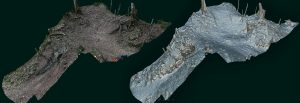
Dr. Alexandre Tokovinine, an assistant professor in UA’s Department of Anthropology, was recently awarded a grant from the National Science Foundation for his archaeological project exploring the cultural and societal changes surrounding the shifting political and cultural allegiances of an ancient Maya settlement in Guatemala.
The $143,000 grant will help Tokovinine and his colleagues excavate La Sufricaya, an ancient Mayan archaeological site that was a suburb of Holmul, the largest city in the region at the time. Like most ancient Mayan cities, the center of town consisted of a large plaza, temples, and a palace. The houses of the nonroyal residents of La Sufricaya were scattered around the center much like today’s modern suburbs.
“With the help of the airborne LiDAR scanner, which laser-maps the surface under the forest canopy, we have a good idea of the extent of the site,” Tokovinine said. “It looks like suburbia. It looks very much like our suburbs, with houses surrounded by gardens and little fields. Every 300 to 400 feet, there’s a cluster of houses, and in the middle of it all there are several open spaces, like the plazas and the temples.”
But what’s more fascinating to Tokovinine is what seems to be the movement of the royal palace from Holmul to La Sufricaya after a new group connected to the site of Teotihuacan in Central Mexico conquered the Holmul region. The 1.2 kilometer move would have, according to Tokovinine, disrupted the local urban landscape, moving not only the palace, but the temples and plazas, as well.
“This means that in the suburbs, you’re not just separated from governance, you’re separated from the gods, from the rituals,” Tokovinine said. “You’re spiritually disconnected. And the question is, what should you do? Would you try to build a new house closer to the palace, especially if you’re part of the government? One thing I’m looking at is whether or not people actually chose to relocate closer to those palaces and temples.”
In addition to urban restructuring, the inhabitants of La Sufricaya changed different aspects of their cultural practices. At the site, Tokovinine and his colleagues have found pottery that matches Mexican styles, murals with images of Teotihuacan warriors and gods, and even volcanic ash in the plaster of the walls of the structures built at the time of the political transition—a construction technique that seems to have been used exclusively at Teotihuacan before this.
After looking further into the shift from one palace to the other, Tokovinine found another chapter of La Sufricaya’s narrative—the new, Mexican-style palace was seemingly abandoned approximately 150 years later in favor of the old palace at Holmul after a the region was conquered by a powerful Maya dynasty from the archaeological site of Dzibanche. And while there is little evidence of Teotihuacan influence in the non-royal residences, the return to the old ways also restored greater commonality in the material culture between the palace of the king and the houses of the subjects. These shifts, Tokovinine says, are why the study of the non-royal structures is important.
“It’s not just about the royal family moving back and forth,” Tokovinine said. “We want to see if people below reacted differently. Right now, we have preliminary data, so I want to excavate more of those houses and see, for example, if house plans changed. Are there any houses that look Mexican at all, or are most of them Mayan residencies?”
While excavating the residential areas, Tokovinine also wants to take scans of different artifacts to create a digital database of data. Since most artifacts cannot be taken out of Guatemala, this is imperative to Tokovinine’s research. He also emphasized that this kind of archiving is useful for educational purposes, both with his graduate students helping with the project and outreach programs through the department.
“We’ll have the large digital database of my artifacts, which will be helpful not just for us, but it’s nice to have three dimensional scans, essential like copies, that you can study better than photographs,” Tokovinine said. “It’s like a virtual copy of the initial sample collection. And it’s also good for teaching. There is a program here at UA called Anthropology is Elemental, which teaches anthropology in elementary schools. In the past, we have tried using different digital tools, including augmented reality, so I think the database will be helpful with that.”